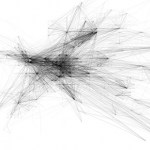William Gibson
The NASA Mars rover Curiosity just landed on Mars. Those of us who tuned in vicariously via NASA's live coverage watched as a roomful of tense engineers exploded, and heard their disembodied voices whispering and booming through the control room. Holy shit. We did it. Their headsets fell askew, they glad-handed one another, criss-crossing the room, and then, immobilized by a sudden hush as the news spread: We've got thumbnails.
Thumbnails. We watched as a tiny image formed, transmuted across the void of space and into this room. It was black and white, an indistinguishable gesture of light…
William Gibson, first in his novel Burning Chrome and then later in the seminal Neuromancer, both coined and defined "cyberspace" as "a consensual hallucination experienced daily by billions of legitimate operators." His novels predate the universal adoption of the World Wide Web as a communication matrix, and his psychedelic fantasy of cyberspace–a kind of semantic space navigated by users in virtual-reality, where information takes form as navigable structures–is not quite (yet) our web, but he was correct in his estimation of the network as a hallucination.
Most of us know, on some…
What's the application? Holograms are images of objects that appear three-dimensional-- if you move your head as you look at a hologram, you will see the usual parallax effects, unlike a normal photograph, which is fixed. So, if your hologram includes one object that is partly behind another object, you can see around the obstruction by moving a bit to the side, just as you would if the original objects were in front of you.
What problem(s) is it the solution to? 1) "How can we jazz up flat images and make them look more lifelike?" 2) "How can we make credit cards harder to copy?"
How does it…

